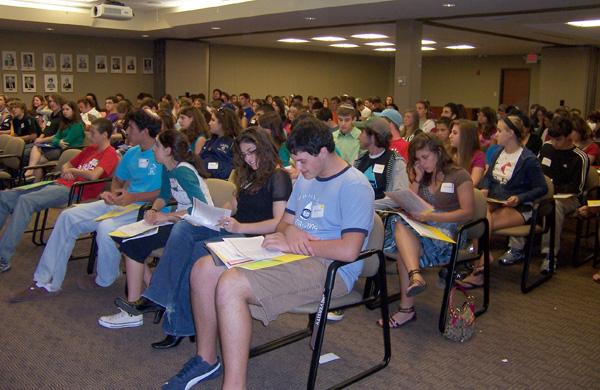JCRC Student-to-Student program educates teens about Judaism
Published May 4, 2010
In 1992, the executive director of the St. Louis Jewish Community Relations Council (JCRC) Batya Abramson-Goldstein, formed the Student-to-Student program with support from the Jewish Federation. Abramson-Goldstein was often invited to speak to area high schools but believed that peer presentations would have a greater impact on students.
Thus, Abramson-Goldstein gathered 10 Jewish high school students to give presentations. Now, Student-to-Student has grown to 154 high school upperclassmen presenting to more than 4,000 students this year alone.
ADVERTISEMENT
“Student-to-Student, a prejudice reduction program of the JCRC, has reached tens of thousands of students since its creation. Participants give presentations to students in St. Louis area parochial and public schools that have little or no contact with Jewish people. Each presenting group has a member of the Conservative, Orthodox, and Reform branches,” Student-to-Student Coordinator Fawn Chapel said.
Depending on the time allotted, Student-to-Student participants present information, in accordance to their personal experiences, about the Jewish life cycle, Shabbat, Israel, Kashrut, the Holocaust, and upcoming Jewish holidays or events using guidelines provided by the JCRC.
“[We] visit schools around the St. Louis area and teach [students] about Israel and the Jewish religion through interactive presentations. A lot of times [presenters] tell anecdotes about certain experiences that we’ve had relating to Judaism. We pass around props, read Hebrew ‘Harry Potter,’ and write Hebrew names on the board,” University City High School senior Stephanie Farber said.
To start off the year, the JCRC hosts a training session to distribute presentation guidelines, provide information and give a mock presentation.
ADVERTISEMENT
“[Chapel] often tells us stories she’s heard about students who heard presentations years ago and, to this day, relish the experience. What’s important is to make sure the students are paying attention, and the best way to do that is to make them a part of the presentation, not just listeners,” Stephanie said.
After the training session, the trainees are split into pre-arranged groups to meet with their leaders (high school seniors who are experienced presenters) to further discuss their presentations and approaches to make them engaging.
“Our groups prepare for about an hour-long lesson to teach students about our culture. We have a rubric that we follow and split up amongst the group. We prepare by meeting up a couple days before [presentations] and discussing who is doing what and what props to bring to make it more interesting for the students,” Ladue Horton Watkins High School senior and group leader Tova Feinberg said.
According to Chapel, Student-to-Student is a great program for developing leadership in addition to sharing cultural information. Past Student-to-Student participants offer tips to make the presentations more interactive and educational.
“Student-to-Student provides an opportunity for the community to understand our religion in a more fun, relaxed way,” Tova added. “The students who have not been exposed to Judaism realize that Jewish people are not that different from themselves. We still do activities like anyone else; we just have some different rituals and beliefs.”
This interaction is a source of pride to Student-to-Student participants. According to the JCRC website, the Student-to-Student program is especially equipped to break down stereotypes and give non-Jewish teenagers a more intimate environment to relate to Jewish teenagers.
“I thoroughly enjoyed the experience of hearing other teens relate their experiences of Judaism through the Student-to-Student program. I think the lesson really gave students [in my class] a chance to put a face to Judaism and also brought to life what we had been reading and learning about on paper,” St. Joseph’s Academy junior Sarah Karchunas said.
The community-wide reception, including St. Joseph’s Academy teacher Dr. Victoria York and Mehlville High School teacher Kate Brindley, has been very positive. York and Brindley heard about the program from other teachers, and they have been an annual visit for the Student-to-Student program for many years.
“When I was given the task of teaching the course on World Religions, I came across the program in notes from the former teacher. I’ve had [Student-to-Student members] coming in to speak to my youngsters for a number of years now,” York said. “The knowledge and commitment of the kids from the JCRC always touches my students. Our students demonstrate a much better understanding of Judaism and, in fact, often tell me that they reflect a good deal on their own faith following the presentation.”
In their book, “Denying History: Who Says the Holocaust Never Happened and Why Do They Say It?” Michael Shermer and Alex Grobman believe a significant number of people think the Holocaust never happened. They argued that if people are uneducated about historical occurrences such as the Holocaust, something similar is bound to happen in the future. According to Chapel and the JCRC website, the overall goal of the Student-to-Student program is to inform students and to eliminate stereotypes that results from misinformation.
“I believe such exchanges [like the Student-to-Student program] are crucial to our youngsters everywhere. Information is the key to ending the stupidity of prejudice. Only the heart and mind can diminish bigotry and fear that arises,” York said. “I believe that’s a major role of education, and Student-to-Student offers this to my students.”
















